The question of whether turkey gravy can be used on chicken is a common one, especially during the holiday season when both dishes are often served together. While both gravies are made with similar ingredients, there are some key differences that may affect the flavor and texture of the dish.
This article will delve into the nuances of turkey and chicken gravy, exploring their similarities and differences, and providing guidance on when it is appropriate to use turkey gravy on chicken.
Similarities and Differences Between Turkey and Chicken Gravy
Ingredients:
Both turkey and chicken gravy are typically made with a combination of drippings from the respective meats, butter, flour, broth, and seasonings. However, there are some variations in the specific ingredients used.
- Turkey gravy: Often includes giblets, such as the heart, liver, and gizzard, which add a richer flavor.
- Chicken gravy: May include additional vegetables, such as onions and carrots, for added sweetness and depth of flavor.
Flavor:
- Turkey gravy: Has a slightly gamier and more savory flavor due to the giblets.
- Chicken gravy: Tends to be milder and sweeter, with a more delicate flavor profile.
Texture:
- Turkey gravy: Can be thicker and richer due to the giblets and the higher fat content of turkey drippings.
- Chicken gravy: Is generally thinner and lighter, with a smoother texture.
When to Use Turkey Gravy on Chicken
While turkey gravy and chicken gravy have distinct characteristics, they can be used interchangeably in certain situations. Here are some guidelines:
- As a substitute: If you don’t have chicken gravy on hand, turkey gravy can be used as a substitute in a pinch. However, it’s important to note that the flavor will be slightly different.
- For a richer flavor: If you prefer a richer and more savory gravy, turkey gravy can be a good option for chicken dishes.
- For a special occasion: Turkey gravy can add a touch of elegance to a chicken dish, especially during the holiday season.
Tips for Using Turkey Gravy on Chicken
- Adjust the seasonings: If using turkey gravy on chicken, you may want to adjust the seasonings to balance the gamier flavor. Adding a pinch of thyme, rosemary, or sage can enhance the flavor profile.
- Thin the gravy: If the turkey gravy is too thick, you can thin it with additional broth or water.
- Use sparingly: Start with a small amount of turkey gravy and add more to taste. Too much gravy can overwhelm the delicate flavor of the chicken.
While turkey and chicken gravy have distinct characteristics, they can be used interchangeably in certain situations. By understanding the similarities and differences between the two gravies, you can make informed decisions about when to use turkey gravy on chicken. Remember to adjust the seasonings and thin the gravy as needed to achieve the desired flavor and texture.
Frequently Asked Questions
Q: Can I use turkey gravy on other dishes besides chicken?
A: Yes, turkey gravy can be used on a variety of dishes, such as mashed potatoes, stuffing, and vegetables.
Q: How can I store leftover turkey gravy?
A: Leftover turkey gravy can be stored in an airtight container in the refrigerator for up to 3 days.
Q: Can I freeze turkey gravy?
A: Yes, turkey gravy can be frozen for up to 2 months. Thaw the gravy in the refrigerator overnight before reheating.
Q: What are some tips for making delicious turkey gravy?
A: Here are some tips for making delicious turkey gravy:
- Use high-quality ingredients.
- Start with a flavorful roux.
- Deglaze the pan with broth or wine.
- Simmer the gravy until it thickens.
- Season to taste.
Should You Make Gravy with a Roux or a Slurry?
Why does this homemade chicken gravy contain a roux and a slurry in addition to flour and cornstarch? I tasted three gravies: one made entirely of flour, one made entirely of cornstarch, and one made with both flour and cornstarch. The flour and cornstarch gravy was by far the best. But first things first, what is a roux? A slurry?.
- To thicken gravies and sauces, fat (typically butter, but it can also be oil or a combination of butter and oil) is cooked with flour until smooth, a process known as a “roux.”
- Cornstarch is combined with a cold liquid (usually broth or water) and whisked until smooth to create a slurry. After that, the slurry is added to the liquid and simmered to thicken.
I prefer to use a roux and slurry because:
- 1) The roux requires less butter, resulting in a gravy with half the fat!
- 2) The flavorful roux helps you instead of a flavorless, thin slurry.
- 3) You enjoy the advantages of both a silkier, smoother slurry-based gravy and a rich, creamy roux-based gravy—that is, the perfect texture and consistency.
- 4) You steer clear of the unduly glossy, sticky texture that slurry gravies sometimes have.

Can I make gravy without chicken drippings?
Yes! That is where this chicken gravy recipe comes in! To replicate the flavor of chicken drippings, we add chicken bouillon to the gravy. It infuses the gravy with intense flavor to make it taste like it’s come from a roasted chicken! Chicken bouillon is created by blending ingredients such as roasted chicken meat, vegetables including onions, celery and carrots, and various seasonings, spices and herbs. It’s all the flavor without all the work.
